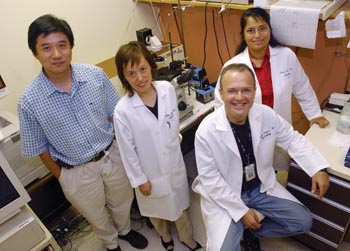
From left, Chuanming Hao, M.D., Ph.D., Yahua Zhang, M.D., Matthew D. Breyer, M.D., and Reena Rao, Ph.D., were some of the collaborators on the paper published in Nature Medicine.
photo by Dana Johnson
Investigators probe edema side effect of popular diabetes drugs
Two of the drugs now commonly used to treat type 2 diabetes have a troubling side effect: they increase fluid retention.
Using mice, Vanderbilt investigators have discovered how these drugs, called thiazolidinediones (trade names Actos and Avandia), cause edema. Their findings, reported this month in Nature Medicine, suggest a specific treatment to reverse this fluid retention.
Thiazolidinedione-associated edema is of special concern for patients who may have underlying heart disease and can ill afford the extra fluid volume, said senior author Matthew D. Breyer, M.D., Catherine McLaughlin Hakim Professor of Medicine and professor of Molecular Physiology & Biophysics. The clinical impact of this problem prompted the American Heart and American Diabetes Associations to issue a joint consensus statement regarding the use of thiazolidinediones and the problem of edema.
Breyer and colleagues came at the issue from an interest in the molecular target of the thiazolidinedione drugs, a protein called PPAR-gamma. Their previous studies had demonstrated expression of PPAR-gamma in the collecting ducts of the kidney — the part of the kidney that controls the final composition of the urine.
“Salt and water absorption are under tight control in the collecting duct, so the localization of PPAR-gamma there suggested to us that it might be regulating this transport,” Breyer said.
To explore this possibility, the researchers treated cultured collecting duct cells with thiazolidinediones. They observed increased sodium transport across the cells, from the “urine” side to the “blood” side, if the cells were in the body.
“We were very excited by this finding, because it gave us a clue about how these drugs might be causing edema,” Breyer said.
The investigators then studied genetically engineered mice that selectively lack the gene for PPAR-gamma only in the collecting duct cells of the kidney.
These mice “don't hang on to salt as well as normal mice,” Breyer said, confirming that PPAR-gamma is playing a role in regulating salt absorption in the whole animal as well as in cultured cells.
In response to the PPAR-gamma-activating thiazolidinedione drugs, normal mice rapidly gained body weight, but the mice lacking PPAR-gamma in the kidney did not gain body weight.
The researchers demonstrated that this weight gain in normal mice was due to fluid weight.
Because PPAR-gamma is known to be a “transcription factor,” a protein that turns other genes on or off, Breyer and colleagues were curious which collecting duct genes were activated during treatment with thiazolidinediones.
They identified a sodium channel called ENaC as a new target gene for PPAR-gamma. The ENaC sodium channel is the major sodium absorptive pathway in the kidney.
Drugs like Actos and Avandia directly increase ENaC expression, Breyer said.
The findings hint at “a previously unrecognized hormonal pathway controlling salt absorption by the kidney,” he added.
The investigators also demonstrated that the diuretic amiloride, which blocks the ENaC channel, prevented fluid retention caused by thiazolidinediones in normal mice.
“Our findings provide a rationale for studies of amiloride as a treatment for patients on thiazolidinediones who develop edema,” Breyer said.
Edema can be especially troubling when its cause is unknown, he added. “Now we have evidence that thiazolidinediones specifically increase sodium absorption in the collecting duct, resulting in fluid retention, at least in mice.
“It should be relatively simple to test whether amiloride provides effective therapy for edema in patients taking this class of anti-diabetic drugs,” Breyer said.
Authors of the Nature Medicine paper include YouFei Guan, Chuanming Hao, Dae Ryong Cha, Reena Rao, Wendell Lu, Mark A. Magnuson, M.D., Reyadh Redha and Yahua Zhang of Vanderbilt and Donald E. Kohan, M.D., Ph.D., of the University of Utah.
The research was supported by the National Institutes of Health, the American Heart Association and a Genzyme Renal Innovative Award.













